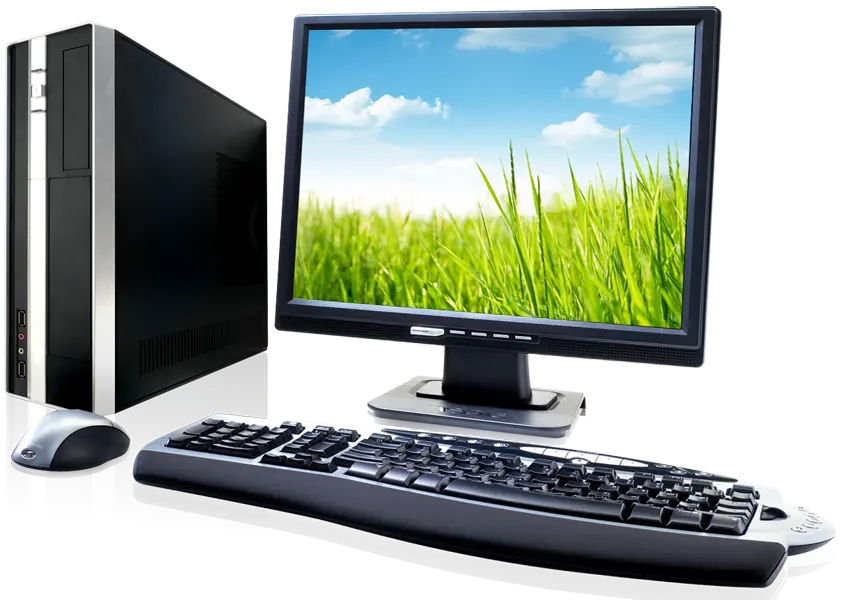Table of Contents
Buying a desktop computer may seem like a straightforward task, browse a few models, check the price, and click “buy”, right?
Wrong.
For many people, especially first-time buyers or even experienced users upgrading from laptops, buying a desktop computer can be filled with hidden traps. From misunderstood specs to limited upgrade options, what seems like a good deal can quickly become a source of regret, and unnecessary expense.
In this guide, we’ll walk you through the five most critical mistakes people make when buying a desktop computer, and more importantly, how to avoid them. Whether you’re shopping for work, gaming, editing, or casual use, this article will give you the confidence to make a smarter, future-proof decision.
1. Focusing Only on Price and Ignoring Performance Needs
This is hands down the most common mistake.
Many users, especially when buying a desktop computer on a budget, focus purely on the price tag. But saving a few hundred riyals today could cost you performance headaches tomorrow.
Ask yourself:
- Will you be using the desktop for casual browsing, or do you need it for gaming, video editing, or business software?
- Are you running lightweight applications or multitasking with multiple tabs and programs?
Performance should always come first. If you’re planning to use heavy software like Adobe Premiere, AutoCAD, or even modern games, you need a strong CPU (at least Intel i5/Ryzen 5), 16GB RAM, and a dedicated GPU. Don’t settle for a machine just because it’s cheap — match your usage needs with the right specs.
Remember, buying a desktop computer should be about performance first, budget second.

2. Overlooking Upgrade Potential and Future-Proofing
What looks perfect today might become outdated next year.
One of the biggest advantages of buying a desktop computer instead of a laptop is the ability to upgrade components as your needs grow. Unlike laptops, desktops often allow you to swap in new parts over time, such as adding more RAM, installing a larger SSD, or even upgrading the graphics card.
But here’s the catch: not all desktops are created equal when it comes to upgradeability. Before buying, ask the following critical questions:
- How many RAM slots are available? Is the memory soldered or expandable?
- Is there space inside the case for an additional SSD or HDD?
- Can the power supply unit (PSU) handle a more powerful GPU in the future?
- Is the motherboard compatible with newer processors or components?
Many pre-built desktops, especially ultra-compact or “all-in-one” designs, come with tightly packed interiors that limit your ability to upgrade. They may look sleek and save space, but they often restrict future expansion, and that means you’re locked into the performance level you buy today.
If you’re a gamer, content creator, or even a casual user who expects to do more in the coming years, it makes sense to invest in a desktop that can grow with you. Choosing a desktop tower with a standard ATX case, modular PSU, and a motherboard that supports newer generations of CPUs and RAM can save you from needing a full replacement later on.
Ultimately, buying a desktop computer with future-proofing in mind gives you more value, more flexibility, and more peace of mind.
3. Ignoring Power Supply and Cooling Requirements
It’s easy to fall for a desktop that looks powerful, bold RGB lights, a sleek case, a tempting price tag, but under the surface, what really matters is how well the machine handles power and heat.
When buying a desktop computer, many people completely overlook one of the most critical components inside the case: the power supply unit (PSU). It’s not the most exciting part, but it’s the heart of your system. A weak or unbranded PSU can lead to major headaches, from random shutdowns and system instability to actual hardware damage over time.
To stay safe and ensure consistent performance, always go for 80 Plus certified power supplies from reputable brands like Corsair, Seasonic, or EVGA. These deliver cleaner power and are more energy-efficient, especially important if you’re using a dedicated graphics card or planning to upgrade later.
Cooling is just as essential, especially with modern CPUs and GPUs that generate serious heat under load. Poor airflow, low-quality fans, or overly compact cases can cause the internal temperature to rise quickly, leading to thermal throttling, where your system intentionally slows itself down to avoid overheating. That means less performance and more frustration.
Look for desktops with:
- At least two case fans (intake and exhaust)
- Well-ventilated cases with mesh panels or airflow-optimized design.
- Room for adding more cooling if needed (especially for gamers or creatives)
Avoid ultra-slim or sealed-off cases unless you’re going for a very basic setup, they might look nice on your desk, but they trap heat and offer very little flexibility.
4. Not Considering Warranty, Support, or Local Compatibility
When it comes to buying a desktop computer, one of the most overlooked, yet most critical, factors is after-sales support and local compatibility. This becomes even more important if you’re ordering from online stores or considering international brands.
A desktop may look like the perfect deal on paper: powerful specs, modern design, great price. But what happens if something goes wrong? If there’s no local warranty or authorized service center, you’re suddenly stuck with shipping delays, costly international repairs, or worse – no support at all.
Always ask:
- Does the brand have official service centers within the country?
- Will I have access to genuine spare parts if something needs replacement?
- Does the warranty cover real-life issues, or is it limited to manufacturer defects?
And beyond support, there’s the matter of compatibility.
Not all desktops sold internationally are plug-and-play in every region. Power voltage standards differ from country to country — and if the device isn’t compatible with local electricity specs or plug types, you could damage it right out of the box or be forced to use adapters that are unreliable in the long run.
Also, pay attention to:
- Keyboard layout (Arabic or English-only?)
- Operating system language, is the interface suitable for your daily use?
- Pre-installed software, does it support local services or regional settings?
These may seem like small details, but they can seriously impact your daily experience and productivity.
So, before you go ahead with buying a desktop computer, especially from abroad or an unfamiliar platform, double-check that the system is fully compatible with your location, your language, and your long-term needs.

5. Choosing the Wrong Platform or Seller
Even if you’ve done all the right homework, compared specs, balanced performance with price, and chosen a trusted brand, there’s one final mistake that can undo everything: buying from the wrong platform or seller.
Many people fall into the trap of relying on general online marketplaces or second-hand listings with little to no quality assurance. These platforms often lack proper product testing, include vague or misleading descriptions, and leave you with zero protection if something goes wrong after the purchase.
You might find an amazing deal at first glance, but without verified sellers, return policies, or post-sale support, it’s a gamble. Once you transfer your money, the seller may disappear. If the product arrives damaged or doesn’t match the listing, you’re often left with no clear way to resolve the issue.
This is where Soum comes in as a game changer.
Soum isn’t just another online store. It’s a curated platform designed specifically to help you buy used and new electronics with confidence, and yes, that includes desktop computers.
Here’s why more smart buyers are buying a desktop computer through Soum:
- Comprehensive pre-sale inspection: Devices are tested and verified before they ever reach your door.
- Fast and reliable delivery across the Kingdom.
- Generous return policy, if something’s not as expected, you have a window to return it hassle-free.
- Verified sellers with real reviews and ratings.
- Access to desktops from the best laptop brand in Saudi Arabia, plus desktops too, with specs that match your needs and prices that fit your budget.
Final Thoughts, buying a desktop computer should feel empowering, not confusing. By avoiding these five mistakes, you’ll save yourself time, money, and a lot of frustration.
So whether you’re gaming, studying, working from home, or building your first creative studio, remember:
- Match the specs to your actual use.
- Think about tomorrow, not just today.
- Buy from a platform that protects your interests.
So, if you’re thinking of buying a desktop computer soon, don’t leave it to chance. Visit Soum and explore desktops that have been reviewed, inspected, and priced to perform.
















